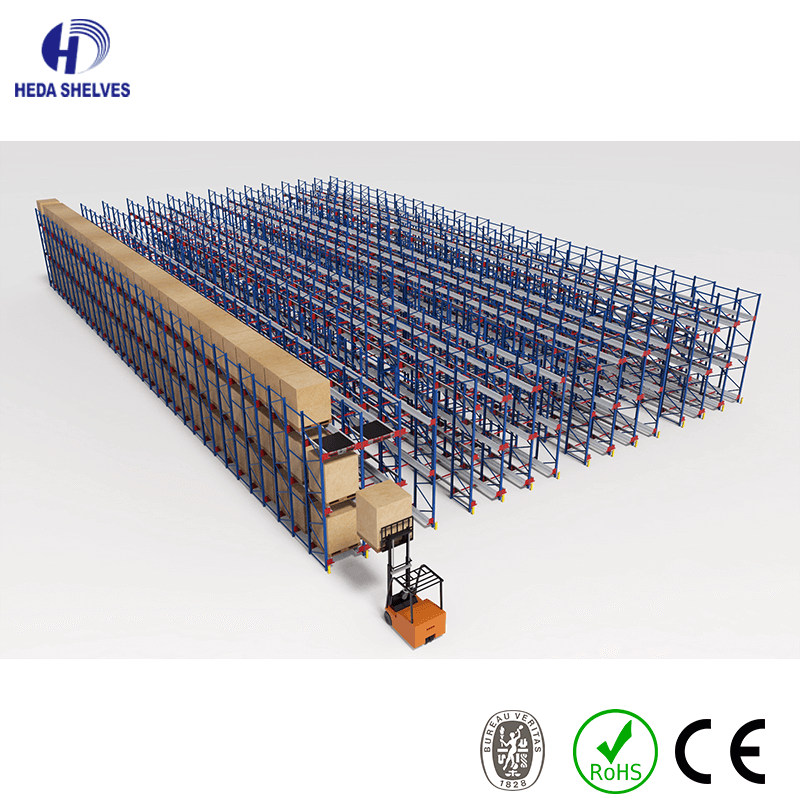In today's competitive warehouse and distribution landscape, maximizing storage capacity while maintaining operational efficiency is paramount. Drive-in racking systems have emerged as a powerful solution for facilities seeking to optimize their storage density without expanding their footprint. This comprehensive guide explores everything you need to know about drive-in racking, from basic concepts to implementation considerations.
What is Drive-In Racking?
Drive-in racking is a high-density storage system that allows forklifts to drive directly into the rack structure to place and retrieve pallets. Unlike traditional selective racking where each pallet is accessible from the aisle, drive-in systems store pallets in continuous rows with minimal structural interruption.
The system operates on a rail-based design where pallets rest on support rails that extend from the rack uprights. Forklifts enter the rack structure through designated openings, traveling along guide rails to reach storage positions deep within the system. This configuration eliminates the need for aisles between each storage position, dramatically increasing storage density.

Key Components
Drive-In vs. Drive-Through Configuration
Drive-In Racking features a single entry point, creating a Last-In-First-Out (LIFO) inventory system. Pallets are loaded and retrieved from the same side, making this configuration ideal for products where inventory rotation is less critical.
Drive-Through Racking provides entry points on both sides of the system, enabling First-In-First-Out (FIFO) inventory rotation. While this configuration requires more floor space due to dual aisle requirements, it offers greater flexibility for inventory management.
Advantages of Drive-In Racking
Maximum Space Utilization
Drive-in racking can achieve storage densities of 75-85%, compared to 50-60% for selective racking systems. This dramatic improvement in space utilization can defer or eliminate the need for facility expansion, providing significant cost savings and improved return on investment.
Reduced Building Costs
Higher storage density translates directly to reduced building requirements. Facilities can store the same quantity of goods in a smaller footprint, lowering construction costs, property taxes, and ongoing operational expenses like heating, cooling, and lighting.
Weather Protection
The consolidated storage design provides better protection for stored goods against environmental factors. Products stored deep within the rack structure are naturally shielded from temperature fluctuations, dust, and other environmental conditions that might affect quality.
Ideal for Bulk Storage
Drive-in systems excel at storing large quantities of identical or similar products. This makes them perfect for manufacturers with seasonal products, food and beverage distributors with bulk commodities, or any operation dealing with high-volume, low-SKU inventory.
Energy Efficiency
Consolidated storage reduces the cubic volume that needs to be heated or cooled, leading to lower energy costs. Additionally, the reduced aisle space means less area requiring lighting during normal operations.
Disadvantages of Drive-In Racking
Limited Selectivity
The primary drawback of drive-in racking is reduced product accessibility. Once pallets are stored deep within a lane, all pallets in front must be removed to access rear positions. This makes the system unsuitable for operations requiring frequent access to individual pallets or multiple SKUs within the same lane.
LIFO Inventory Constraints
The single-entry drive-in configuration naturally creates a LIFO inventory flow, which can be problematic for products with expiration dates or strict rotation requirements. While drive-through systems can address this limitation, they require additional floor space.
Slower Product Retrieval
Retrieving pallets from deep storage positions takes longer than accessing products in selective racking. This can impact overall warehouse productivity, particularly during peak order fulfillment periods.
Higher Equipment Wear
Forklifts operating within rack structures experience increased wear due to the precision required for maneuvering in confined spaces. This can lead to higher maintenance costs and more frequent equipment replacement.
Structural Vulnerability
Drive-in racks are more susceptible to damage from forklift impacts. Contact with uprights or rails can potentially affect structural integrity, and the interconnected nature of the system means localized damage can have broader implications.
Reduced Warehouse Flexibility
Once installed, drive-in systems are less flexible than selective racking for accommodating different pallet sizes or changing storage requirements. Reconfiguration typically requires more extensive modifications.
Drive-In Racking for Warehouse/Industrial Facilities: What to Consider
Inventory Characteristics Analysis
Facility Design Requirements
Equipment Compatibility Assessment
Safety and Risk Management
Fire Safety and Code Compliance
Economic Analysis Framework
Technology Integration Opportunities
Making the Right Decision
Drive-in racking represents a significant investment and operational change that can deliver substantial benefits when properly implemented. The key to success lies in thoroughly analyzing your specific requirements and constraints before making a commitment.
Start by conducting a comprehensive inventory analysis to identify products suitable for drive-in storage. Evaluate your facility's physical constraints and equipment capabilities. Most importantly, consider how drive-in racking aligns with your long-term business strategy and growth plans.
Remember that drive-in racking isn't an all-or-nothing proposition. Many successful implementations use a hybrid approach, combining drive-in systems for appropriate products with selective racking for items requiring frequent access. This balanced approach can optimize both storage density and operational efficiency.
The decision to implement drive-in racking should be based on solid data analysis, careful planning, and realistic expectations about both benefits and limitations. When properly planned and executed, drive-in racking can transform warehouse operations, delivering significant improvements in space utilization, cost efficiency, and competitive advantage.
If you’re finding Drive-in/thru racking system, feel free to contact us at abby@hedashelf.cn for technical and pricing support.



Hi! Click one of our members below to chat on





